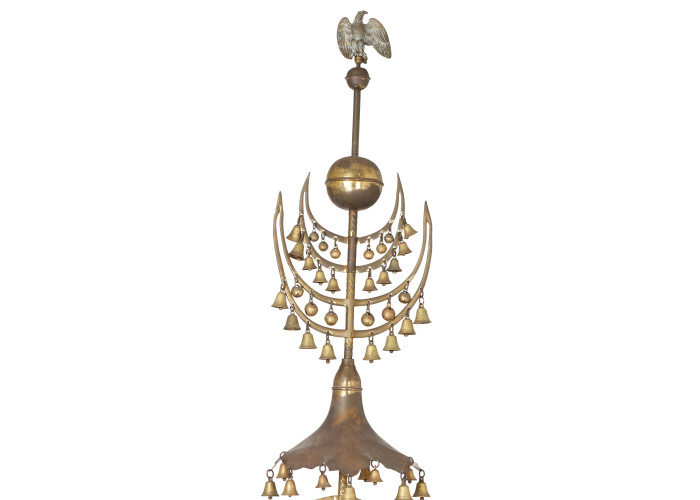Jingling Johnnie
This unusual musical instrument is variously known as a Turkish crescent, a Chapeau Chinois (“Chinese Hat”) by the French and a Jingling Johnnie by the English. It was used in the Middle East, and was introduced to western Europe after Napoleon’s invasion of Egypt in 1798. By 1815 it was so popular that the bands of several British regiments who fought at the Battle of Waterloo carried Jingling Johnnies.
In 1798, Napoleon Bonaparte led a French army of over 40,000 men that invaded Egypt, at that time ruled by the Ottoman Empire. This musical instrument was captured from the Ottoman army by French soldiers who surmounted it with an eagle. In turn, it was taken from the French by the Irish Connaught Rangers at the Battle of Salamanca in 1812. It became an object of veneration and was carried by the tallest man in the regiment in front of the band on ceremonial parades until 1922, when the regiment was disbanded. The original became so fragile that a replica was made consisting of a staff, the eagle at the top, a middle roundel with hanging bells and a crescent-shaped third tier decorated with more bells and two horsetail plumes. The bells jingled when it was twisted or shaken.
Intrigued by exotic Eastern culture, European military bands adopted the Turkish crescent from the Janissary bands of the Ottoman Empire in the 18th century. They also copied the use of bass drums, tambourines and cymbals. To add to the oriental glamour of their bands they often employed black men to play these instruments. The band of the Coldstream Guards carried a Jingling Johnnie at Waterloo. In the Guards Museum in London a set of 4 model turbanned black bandsmen, one of whom is carrying a Jingling Johnnie, can be purchased for £60.
The Black Brunswickers were presented with a Jingling Johnnie by Queen Charlotte while they were stationed on the Isle of Wight, before they joined Wellington in the Peninsula. The instrument became unfashionable with the British military around the mid 19th century but is still used for ceremonial purposes by French military bands, most famously the French Foreign Legion. It is also still in use by some German, Russian, Chilean and Brazilian military bands.
-
Curatorial info
- Accession Number: NAM. 1956-02-868
-
Use this image
- Rights Holder: Copyright National Army Museum. Photography Relic Imaging Ltd.
- License Type: Creative Commons
Find it here
This object is in the collection of National Army Museum









